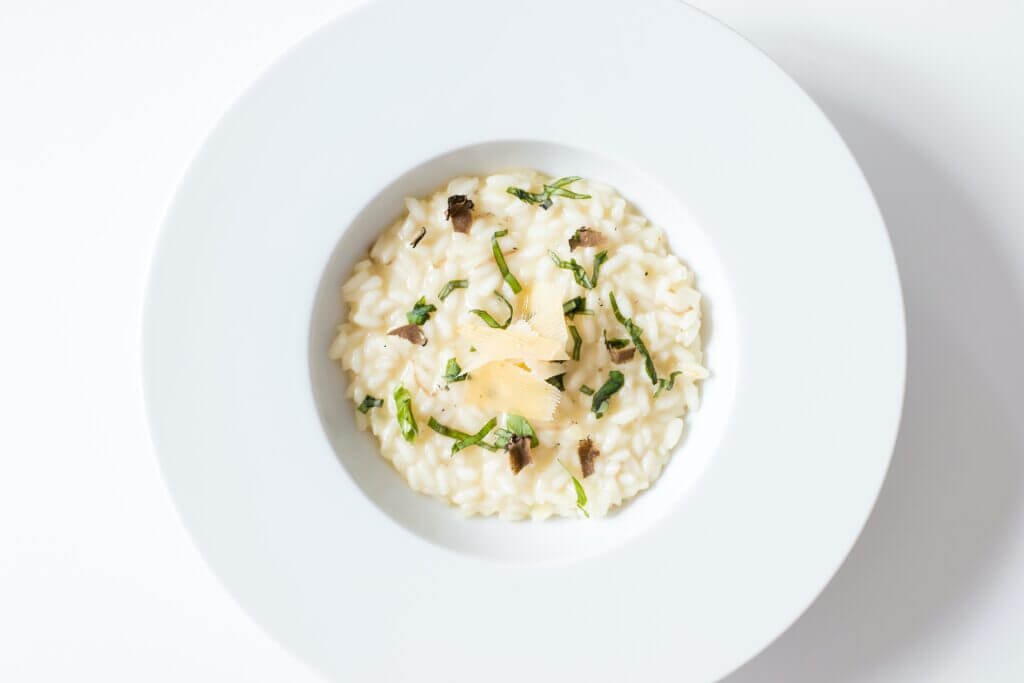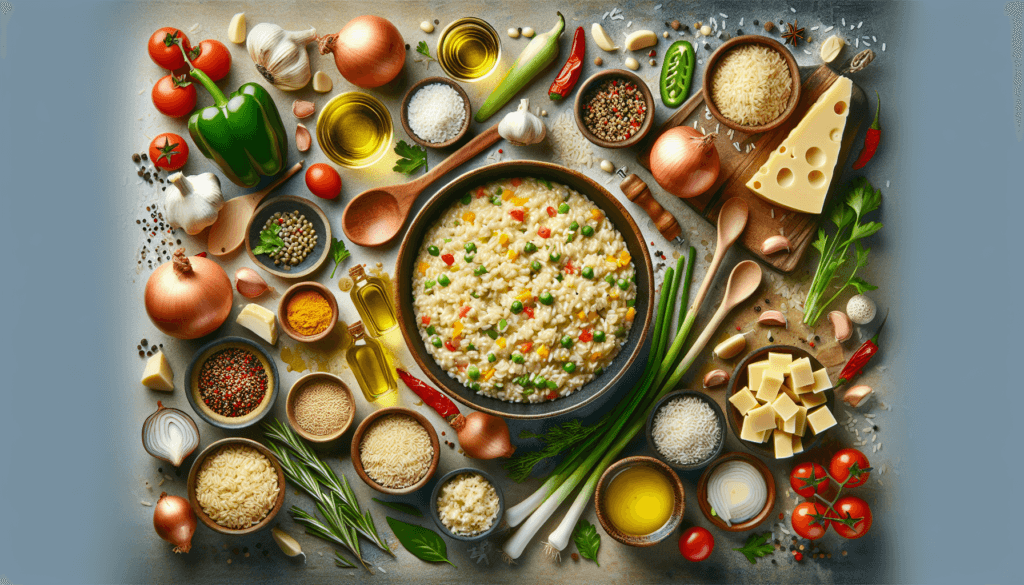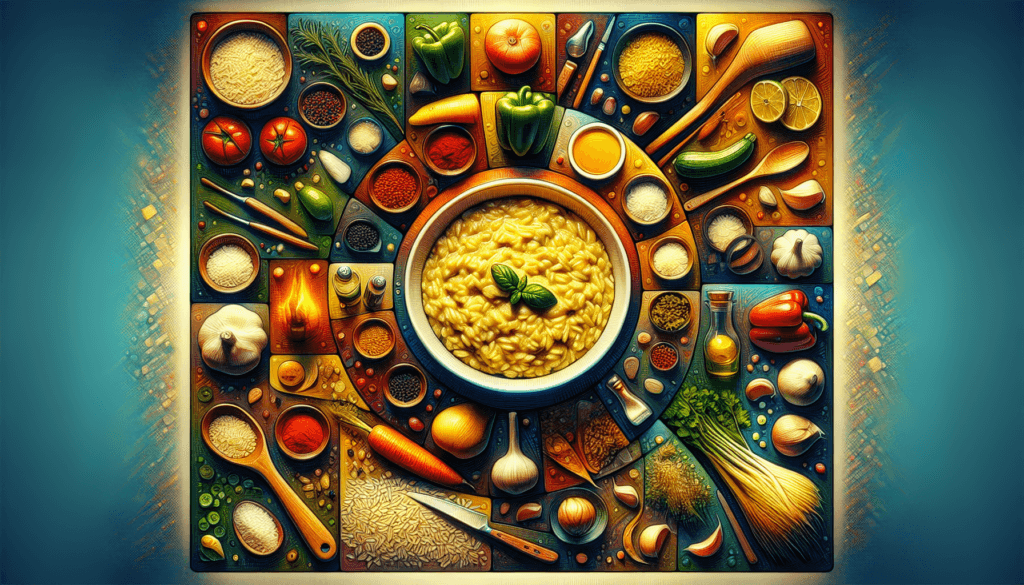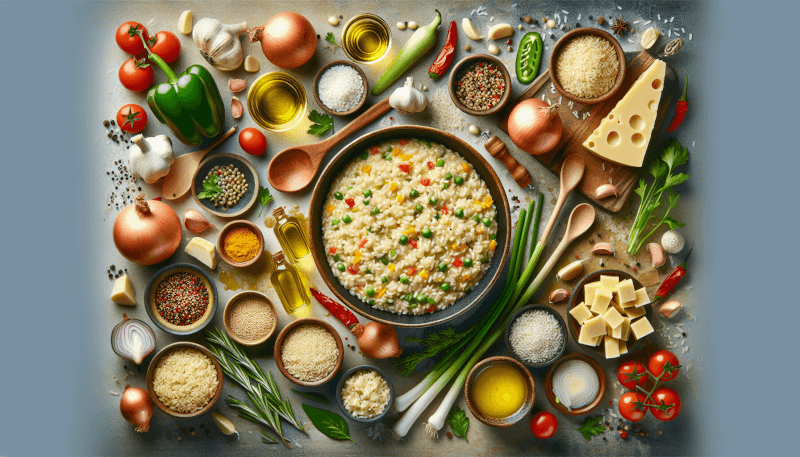Imagine craving a warm, comforting meal that hugs your taste buds in every spoonful. You find yourself yearning for the creamy, rich flavors of risotto, but have no idea where to start. Fret not, for this article will guide you through the step-by-step process of cooking a delicious bowl of risotto that will leave you feeling satisfied and content. So grab your apron and let’s embark on a culinary adventure together!

Choosing the Right Ingredients
Selecting the Type of Rice
The key to making a delicious risotto starts with selecting the right type of rice. Arborio rice is the most commonly used variety due to its high starch content, which gives the risotto its creamy texture. Other options to consider include Carnaroli and Vialone Nano, which also have a high starch content. These varieties are widely available in grocery stores and specialty food shops.
Choosing the Broth
Broth plays a crucial role in the flavor of your risotto. Opt for a high-quality broth, such as homemade chicken or vegetable broth, for the best results. If using store-bought broth, choose one that is low in sodium to have better control over the seasoning. You can also customize your risotto by using different types of broth, such as mushroom broth or seafood stock, depending on the flavor profile you want to achieve.
Adding Aromatics
Aromatics like onions, garlic, and shallots are essential for enhancing the flavor of your risotto. Begin by finely chopping these aromatics to release their flavors. Heat some olive oil or butter in a large, wide saucepan on medium heat and sauté the aromatics until they turn translucent and fragrant. This step creates a flavor base that will infuse your risotto with deliciousness.
Incorporating Vegetables
Vegetables add color, texture, and nutritional value to your risotto. Consider using vegetables like mushrooms, asparagus, peas, or butternut squash, depending on your preference. Before incorporating them into the risotto, ensure that they are properly chopped and prepared. Sauté them with the aromatics to allow the flavors to meld together and intensify.
Selecting the Cheese
Cheese adds richness and creaminess to your risotto. Choose a cheese that melts well and complements the other flavors in your dish. Parmigiano-Reggiano is a classic choice for its nutty and salty taste, while Fontina or Gruyère can add a slightly milder flavor. Experiment with different cheeses to find the one that suits your taste preferences.
Deciding on Additional Ingredients
To elevate your risotto, you can add additional ingredients such as herbs, spices, meats, or seafood. Fresh herbs like thyme, rosemary, or parsley can enhance the overall aroma and taste. Meats like pancetta or sausage can add a savory element, while seafood like shrimp or scallops can bring a delightful seafood flavor to the dish. Get creative and choose ingredients that complement each other well.
Preparing the Ingredients
Rinsing the Rice
Rinsing the rice before cooking helps remove excess starch, preventing your risotto from becoming too sticky. Place the rice in a fine-mesh sieve and rinse it under cold water until the water runs clear. This step is crucial for achieving the perfect texture in your risotto.
Chopping the Aromatics and Vegetables
For even cooking and distribution of flavors, it’s essential to chop the aromatics and vegetables into uniform pieces. Finely chop the garlic, onions, shallots, and any additional vegetables that you plan to include in your risotto. A consistent size will ensure that they cook evenly and blend seamlessly into the dish.
Grating the Cheese
Grating the cheese before starting the cooking process makes it easier to incorporate into the risotto later on. Use a box grater or a microplane grater to finely grate the cheese. Having the cheese ready will help save time and ensure that it melts smoothly into the risotto, adding a delightful creaminess.
Preparing Additional Ingredients
If you’re adding meats or seafood to your risotto, make sure they are cooked and prepared ahead of time. For example, if you’re using pancetta, cook it until crispy and set it aside. If you’re incorporating shrimp, make sure they are peeled, deveined, and cooked so that they are ready to be added to the risotto. Preparing additional ingredients beforehand will streamline the cooking process.

Mastering the Cooking Technique
Sautéing the Aromatics
Once you’ve prepped your aromatics, heat a tablespoon of olive oil or butter in a large saucepan over medium heat. Add the chopped onions, garlic, and shallots and sauté them until they become translucent and aromatic. This step is crucial for building the base flavors of your risotto.
Toasting the Rice
Toasting the rice helps bring out its nutty flavor and creates a firm outer layer that will prevent it from becoming mushy. Add the rice to the pan with the sautéed aromatics and stir continuously for a minute or two until the rice grains are coated with the oil or butter. The rice should give off a subtle nutty aroma during this process.
Adding the Liquid
Once the rice is toasted, it’s time to gradually add the liquid. Traditional risotto is made by adding hot broth to the rice, one ladleful at a time, allowing the rice to absorb the liquid before adding more. This slow addition of hot liquid ensures that the rice cooks evenly and releases its starch to create a creamy consistency. Stir constantly as you add the broth to prevent the rice from sticking to the pan.
Stirring and Simmering
Stirring the risotto during the cooking process helps release the starch and creates the desired creamy consistency. It’s important to continuously stir the rice as you gradually add the hot broth, allowing the rice to absorb the liquid and release its starch. Keep the heat at a gentle simmer to ensure even cooking and prevent the rice from sticking to the pan.
Testing for Doneness
Since risotto is cooked to a specific texture, it’s important to test for doneness. The rice should be tender yet slightly firm to the bite, with a creamy consistency. To check for doneness, taste a few grains of rice to ensure they are cooked to your liking. If the rice is still too firm, continue adding broth and stirring until it reaches the desired consistency.
Adding Flavor and Creaminess
Incorporating Wine
Adding a splash of wine to your risotto can enhance the flavors and add depth to the dish. Use a dry white wine, such as Chardonnay or Pinot Grigio, and pour it into the pan after toasting the rice. Allow the wine to simmer and evaporate, stirring constantly until it has been absorbed by the rice. The wine will infuse the risotto with a subtle acidity and enhance its overall taste.
Enhancing with Butter
For extra richness and flavor, add a tablespoon of butter or olive oil to the risotto towards the end of the cooking process. The butter will give the risotto a silky texture and a luxurious taste. Stir it in until fully melted and incorporated. This step is optional but highly recommended for those looking to take their risotto to the next level.
Creating a Mirepoix Variation
A mirepoix is a mixture of finely diced onions, carrots, and celery that provides a flavorful base in many dishes. To create a mirepoix variation in your risotto, add finely chopped carrots and celery along with the onions and sauté them together. This variation adds depth and complexity to the overall flavor profile of your risotto.
Infusing with Herbs and Spices
Herbs and spices can elevate the taste of your risotto by adding layers of flavor. Stir in fresh or dried herbs like thyme, rosemary, or parsley during the cooking process to infuse the dish with their aromatic qualities. Additionally, spices like smoked paprika, saffron, or nutmeg can bring unique and bold flavors to your risotto. Experiment with different combinations to find your favorite flavors.
Adding Cream or Mascarpone
For a lusciously creamy risotto, consider adding a splash of cream or stirring in a dollop of mascarpone cheese at the end of the cooking process. This step adds richness and a velvety texture to the dish. Add the cream or mascarpone gradually, stirring constantly until well incorporated. Keep in mind that this step is optional and can be adjusted based on your personal preference.

Experimenting with Different Variations
Mushroom Risotto
Mushroom risotto is a classic variation that highlights the earthy and savory flavors of mushrooms. Start by sautéing a variety of mushrooms, such as cremini, shiitake, or porcini, along with the onions and garlic. The mushrooms will release their juices, adding depth and complexity to the risotto. Finish with a sprinkle of fresh parsley or thyme for a delightful twist.
Asparagus Risotto
Asparagus risotto is a perfect option for spring when asparagus is in season. Blanch the asparagus spears and cut them into bite-sized pieces before adding them to the risotto. Their vibrant green color and tender texture will make your risotto visually appealing. Top it off with a drizzle of lemon juice to add a refreshing and tangy note.
Seafood Risotto
Seafood lovers will delight in a seafood risotto that features a medley of fresh seafood like shrimp, scallops, mussels, or clams. Cook the seafood separately and add it to the risotto towards the end of the cooking process to prevent overcooking. The seafood will infuse the dish with a briny and oceanic taste, making it a true delight for seafood enthusiasts.
Truffle Risotto
Truffle risotto is a luxurious variation that showcases the earthy and complex flavors of truffles. Infuse the risotto with truffle flavor by using truffle oil, truffle salt, or truffle paste. Add a small amount at a time, tasting as you go to avoid overpowering the other flavors. Top it off with a sprinkle of grated Parmigiano-Reggiano and enjoy a gourmet experience at home.
Pumpkin or Butternut Squash Risotto
During the fall season, pumpkin or butternut squash risotto is a delightful choice that perfectly captures the essence of autumn. Roast or sauté the pumpkin or squash until tender and mash it into a puree. Incorporate the puree into the risotto during the cooking process to infuse it with a comforting sweetness. Top with toasted pumpkin seeds for added crunch and flavor.
Mastering the Art of Risotto
Achieving the Perfect Texture
The texture of risotto should be creamy, with the rice grains cooked al dente. To achieve this, ensure that you add the hot broth gradually, stirring constantly and allowing the rice to absorb the liquid between each addition. Consistent stirring and a gentle simmer will release the starch and create the desired creaminess.
Balancing Flavors
Balancing flavors is crucial in creating a delicious risotto. Taste as you go and adjust the seasoning accordingly. If the risotto feels too bland, add a pinch of salt. If it lacks acidity, a squeeze of lemon juice can brighten the flavors. Remember that the cheese also adds saltiness, so taste before adding additional salt.
Developing a Creamy Consistency
To develop a creamy consistency, stir the risotto slowly and consistently. The constant stirring helps release the starch from the rice, creating a velvety, creamy texture. As the risotto cooks, it will naturally thicken and become richer. If desired, you can add a splash of cream or mascarpone towards the end for an extra creamy finish.
Avoiding Common Mistakes
The most common mistake when making risotto is overcooking. Pay close attention to the cooking time and ensure that the rice is cooked al dente. Overcooked risotto will be mushy and lack the desirable texture. Also, avoid adding too much liquid at once, as it can result in soupy risotto. Gradual addition and constant stirring are key to achieving the perfect consistency.
Adjusting the Seasonings
Once your risotto is cooked, taste and adjust the seasonings as needed. Add more salt, pepper, or any other desired herbs or spices to enhance the flavors. Remember that the flavors will continue to develop as the risotto sits, so it’s important to make any final adjustments before serving.

Serving and Garnishing
Plating the Risotto
To plate the risotto, use a wide bowl or shallow plate to showcase the vibrant colors and creamy texture. Use a spoon or ladle to carefully transfer the risotto from the pan to the plate, ensuring an even distribution. Avoid spreading the risotto too thin, as it should be served in a generous, comforting mound.
Sprinkling with Grated Cheese
Just before serving, sprinkle the surface of the risotto with freshly grated cheese. Use a hard cheese like Parmigiano-Reggiano or Pecorino Romano for a sharp, nutty flavor. The cheese will melt into the risotto, adding a final touch of creaminess and enhancing the overall taste.
Adding Fresh Herbs
To add a pop of freshness and brightness to your risotto, garnish with a handful of fresh herbs. Sprinkle chopped parsley, basil, or chives on top of the risotto just before serving. The herbs will not only add a burst of color but also contribute a delightful aroma and mild herbaceous flavor.
Garnishing with Crispy Toppings
For added texture and flavor, consider garnishing your risotto with crispy toppings. Crispy pancetta, bacon, or prosciutto can provide a satisfying crunch and savory contrast to the creamy risotto. Sprinkle the crispy topping on the surface of the risotto, allowing it to shine through as a delicious addition.
Drizzling with Truffle Oil
For a final touch of elegance and depth of flavor, drizzle your risotto with a high-quality truffle oil. Truffle oil adds a distinct earthy flavor that complements the creamy richness of the risotto. Use it sparingly, as a little goes a long way, and enjoy the luxurious aroma and taste it brings to your dish.
Pairing Risotto with Complementary Dishes
Pairing with Meat or Poultry
Risotto pairs well with a variety of meats and poultry. Serve it alongside grilled chicken, roasted turkey, or seared steak for a satisfying and hearty meal. The creamy risotto will balance out the protein and add a touch of sophistication to the dish.
Accompanying with Seafood
Seafood and risotto are a match made in culinary heaven. The creamy texture of the risotto complements the delicate flavors of seafood beautifully. Serve your risotto with grilled shrimp, seared scallops, or pan-fried fish for a delightful seafood feast.
Serving with Vegetarian Options
Risotto can easily be adapted to suit vegetarian diets. Pair it with roasted vegetables like roasted butternut squash, grilled asparagus, or sautéed mushrooms for a flavorful and satisfying vegetarian meal. The rich and creamy risotto will highlight the flavors and textures of the vegetables.
Choosing the Right Wine
When it comes to wine pairings, the choice depends on the flavor profile of your risotto. For a classic risotto, consider a dry white wine like Chardonnay or Pinot Grigio. For mushroom risotto, opt for a medium-bodied red wine like Pinot Noir or Barbera. Seafood risotto pairs well with a crisp white wine such as Sauvignon Blanc or Chardonnay.
Pairing with Salads or Soups
To create a well-rounded meal, consider pairing your risotto with a fresh salad or a comforting soup. For salads, opt for light and refreshing options like a citrus salad or arugula salad. For soups, try a creamy vegetable soup or a tomato bisque. The contrast between the risotto and the side dish will add depth and balance to your meal.

Tips and Tricks for Success
Prepping Ingredients in Advance
To save time and streamline the cooking process, prep your ingredients in advance. Chop the aromatics, grate the cheese, and prepare any additional ingredients ahead of time. This way, when you’re ready to start cooking, all the ingredients will be within reach, making the process more efficient and enjoyable.
Keeping the Broth Warm
To ensure a consistent temperature while cooking the risotto, keep the broth warm on a separate burner. This helps the rice grains cook evenly and prevents the temperature from dropping when adding the broth to the pan. Warm broth will be absorbed more easily by the rice, resulting in a better texture and taste.
Using a Wide and Shallow Pan
To facilitate even cooking and proper stirring, use a wide and shallow pan or skillet for making risotto. This ensures that the rice is spread out in a thin layer, allowing it to cook more evenly. The wide surface area also provides more room for the liquid to evaporate and the flavors to meld together.
Maintaining Consistent Heat
When making risotto, it’s important to maintain a consistent heat throughout the cooking process. Too high of a heat can cause the liquid to evaporate too quickly, resulting in undercooked rice. Too low of a heat can lead to overcooking and a mushy texture. Keep the heat at a gentle simmer, adjusting as needed to achieve the desired consistency.
Avoiding Overcooking
To avoid overcooking the rice, keep a close eye on the cooking time and test the rice for doneness. Aim for a tender yet slightly firm texture, known as al dente. Overcooking will result in mushy risotto, so be vigilant and adjust the cooking time as needed to achieve the perfect consistency.
Adding a Personal Touch to Your Risotto
Incorporating Unique Ingredients
Make your risotto stand out by incorporating unique and unexpected ingredients. Experiment with additions like truffle paste, saffron threads, roasted garlic, or sun-dried tomatoes to create your own signature flavor profile. Don’t be afraid to get creative and add ingredients that reflect your personal taste and culinary preferences.
Experimenting with Different Cooking Techniques
While the traditional method of making risotto is tried and true, don’t be afraid to experiment with different cooking techniques. You can try baking the risotto in the oven instead of cooking it on the stovetop or even using a pressure cooker for quicker results. These alternative methods may yield slightly different textures and flavors, providing a new twist to your risotto.
Creating Fusion Flavors
Infuse your risotto with flavors from different cuisines to create fusion-inspired dishes. Combine Asian flavors like ginger, soy sauce, and sesame oil for an Asian-inspired risotto. Add Mexican spices like cumin, chili powder, and cilantro for a Mexican twist. The possibilities are endless, so let your taste buds guide you and have fun experimenting with fusion flavors.
Customizing the Garnish
Get creative with the garnish and customize it to your liking. Instead of the traditional grated cheese, consider using crumbled feta, shaved Parmesan, or a sprinkle of nutritional yeast for a vegan option. Top the risotto with toasted nuts, fried sage leaves, or even edible flowers to add a touch of elegance and visual appeal.
Developing Signature Risotto Recipes
Put your own stamp on risotto by developing your signature recipes. Experiment with different combinations of ingredients, cooking techniques, and flavors until you find your own unique twist on this classic dish. Whether it’s a spicy risotto with chorizo or a citrus-infused risotto with grilled shrimp, developing signature recipes can be a rewarding way to showcase your culinary creativity and skills.
Now that you have a comprehensive guide to cooking a warm and comforting bowl of risotto, it’s time to gather your ingredients, roll up your sleeves, and embark on this delicious culinary adventure. With the right ingredients, techniques, and a touch of your personal flair, you’ll be able to create a risotto masterpiece that will impress both yourself and your lucky dining companions. Happy cooking!


